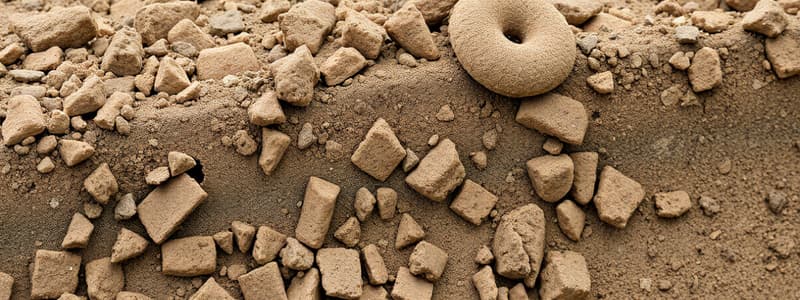Podcast
Questions and Answers
What is the process called that involves breaking down rocks into smaller pieces?
What is the process called that involves breaking down rocks into smaller pieces?
- Weathering Process (correct)
- Sedimentation
- Soil Erosion
- Soil Formation
Which type of soil is formed from the decomposition of aquatic plants?
Which type of soil is formed from the decomposition of aquatic plants?
- Organic Soils (correct)
- Residual Soils
- Glacial Soils
- Transported Soils
What is a key characteristic of fine-grained soils compared to coarse-grained soils?
What is a key characteristic of fine-grained soils compared to coarse-grained soils?
- Absence of cohesion
- Larger grain size
- Higher permeability
- Presence of cohesion (correct)
Boulder clay is also known as which of the following terms?
Boulder clay is also known as which of the following terms?
Which of the following types of soils remain where they were formed?
Which of the following types of soils remain where they were formed?
What is the average grain size that classifies a soil as coarse-grained?
What is the average grain size that classifies a soil as coarse-grained?
Which type of soil is specifically known for its high degree of shrinkage and swelling due to montmorillonite content?
Which type of soil is specifically known for its high degree of shrinkage and swelling due to montmorillonite content?
What type of soil is characterized by being transported by physical processes such as gravity and water?
What type of soil is characterized by being transported by physical processes such as gravity and water?
What is the primary characteristic of loam soil?
What is the primary characteristic of loam soil?
Which soil structure is typical of coarse-grained soils?
Which soil structure is typical of coarse-grained soils?
What is flocculation in the context of soil structure?
What is flocculation in the context of soil structure?
What defines the term 'soil texture'?
What defines the term 'soil texture'?
Which type of soil structure primarily involves inter-particle forces?
Which type of soil structure primarily involves inter-particle forces?
What is a significant property of loess soil?
What is a significant property of loess soil?
What characterizes the honey-comb structure in soils?
What characterizes the honey-comb structure in soils?
Which of the following statements about marl is true?
Which of the following statements about marl is true?
Flashcards are hidden until you start studying
Study Notes
Rock Cycle
- Three main types of rocks: Igneous, Sedimentary, and Metamorphic.
Weathering Process
- Breakdown of rocks into smaller pieces through mechanical and chemical processes.
- Mechanical Weathering involves physical forces, while Chemical Weathering involves chemical reactions.
Soil Profile
- Natural succession of zones or strata below ground, altered by weathering processes.
- Depths and thickness of strata vary based on location.
Transported Soils
- Soils moved by physical processes to different locations include:
- Gravity transported soils
- Lacustrine soils (from lakes)
- Alluvial or fluvial soils (from rivers)
- Glacial soils (from glaciers)
- Aeolian soils (from wind)
- Marine soils (from oceans)
Residual Soils
- Soils that remain in the place of formation, covering the underlying rock surface.
Organic Soils
- Formed from decomposed aquatic plants, typically in coastal and glaciated regions.
Broad Classification of Soils
- Coarse-grained soils: Grain size greater than 0.075 mm (e.g., gravel and sand).
- Fine-grained soils: Grain size less than 0.075 mm (e.g., silt and clay).
- Fine-grained soils exhibit cohesion due to intermolecular attraction, while coarse-grained soils are non-cohesive.
Commonly Used Soil Designations
- Bentonite: Volcanic ash decomposed into clay, known for high shrink/swell capacity.
- Black Cotton Soil: Rich in montmorillonite, known for its ability to support cotton growth.
- Boulder Clay: Glacial clay containing various sizes of rock fragments, known as glacial till.
- Loam: Mixture of sand, silt, clay, and potentially organic matter.
- Loess: Wind-blown yellowish-brown silt/clay, cohesive when dry and loses cohesion when wet.
- Marl: Mixture of calcareous material with clay, containing specific proportions of lime and clay.
Soil Structure
- Refers to the arrangement and state of aggregation of soil grains. Types include:
- Single-grained structure: Characteristic of coarse-grained soils; gravitational forces dominate.
- Honey-comb structure: Found in fine-grained soils; smaller grains settle with significant inter-particle forces.
- Flocculent structure: Common in clays; involves flocculation and the form of aggregates called flocs.
Soil Texture
- Defined by the appearance and surface characteristics of soil, primarily influenced by particle size, shape, and gradation.
Studying That Suits You
Use AI to generate personalized quizzes and flashcards to suit your learning preferences.



